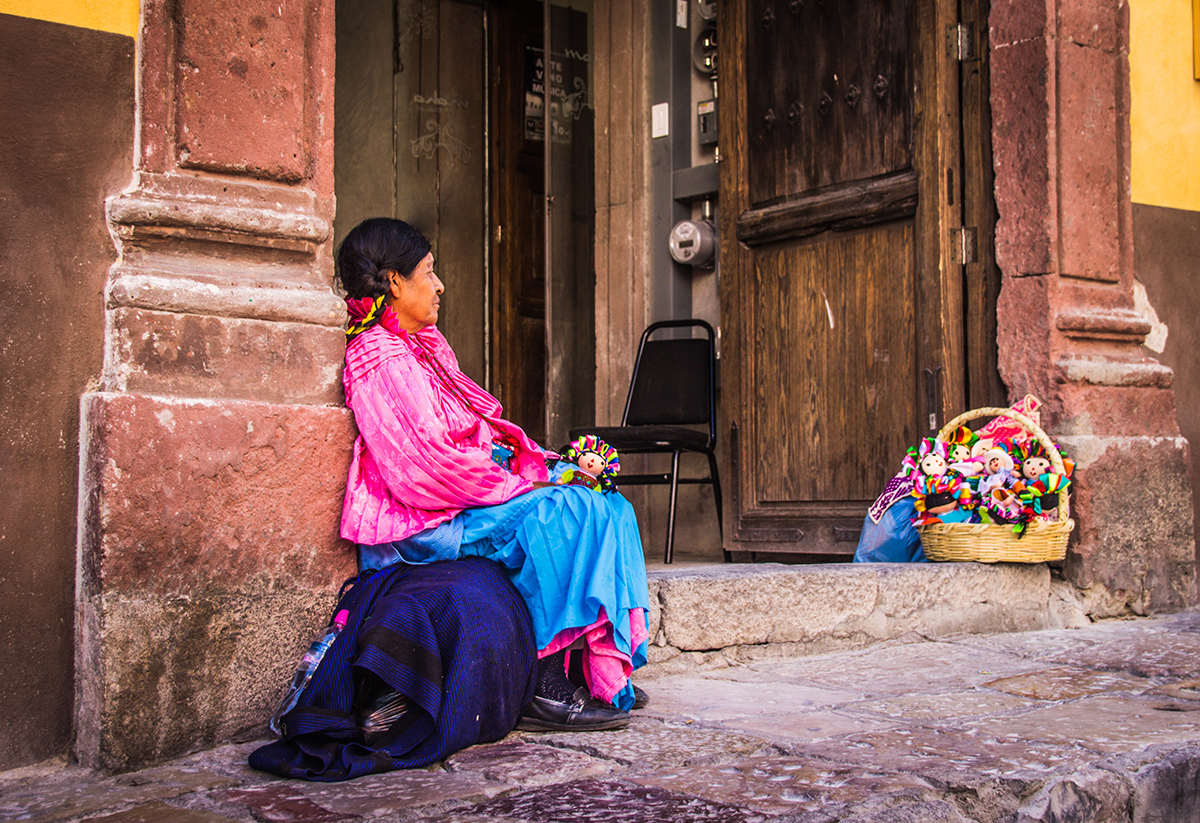
November is Native American Heritage Month, which celebrates and honors indigenous American peoples and commemorates their histories and cultures.
The term Indigenous peoples of the Americas refers to the people who inhabited the Americas before European colonization in the 15th century. Though many stereotypes exist of what an Indigenous person is, from old Hollywood westerns to history texts written from the perspective of the colonists, the reality is often very different and neither simplistic nor homogenous. Today, there are roughly 70 million people who identify as Indigenous. There are over 1000 languages spoken. In the United States alone, 574 tribes are formally recognized. These numbers indicate a wide diversity in the history, cultures and languages experienced by peoples and groups who identify as Indigenous peoples.
A physical book display will be available at the Libraries with the selection rotating weekly. Some of the eBooks listed below also have a physical listing. Please check the availability. Special thanks to our Materials Processing Coordinator Leah Zande for compiling this list.
Mapping Time, Space and the Body
Ferreira, Mariana Kawall Leal (2015)
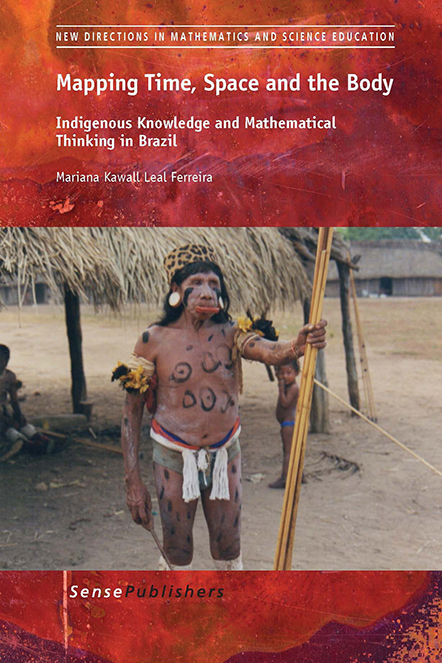 "Mapping Time, Space and the Body: Indigenous Knowledge and Mathematical Thinking in Brazil" brings people, land and numbers together in the fight for justice. On this extraordinary voyage through ancestral territories in central and southern Brazil, the Xavante, Suyá, Kayabi, and other local nations use mapping as a tool to protect their human rights to lands and resources they have traditionally owned and acquired.
"Mapping Time, Space and the Body: Indigenous Knowledge and Mathematical Thinking in Brazil" brings people, land and numbers together in the fight for justice. On this extraordinary voyage through ancestral territories in central and southern Brazil, the Xavante, Suyá, Kayabi, and other local nations use mapping as a tool to protect their human rights to lands and resources they have traditionally owned and acquired.
Mathematics activities inside the classroom and in everyday life help explain how Indigenous Peoples understand the cosmos and protect the living beings that helped create it. The book is a welcome contribution to a growing literature on the mathematical and scientific thinking of Indigenous Peoples around the globe. It makes mathematics alive and culturally relevant for students of all national backgrounds worldwide. - Publisher's Description
Request this Title
Indigenous Women's Movements in Latin America
Rousseau, Stéphanie; Morales Hudon, Anahi (2015)
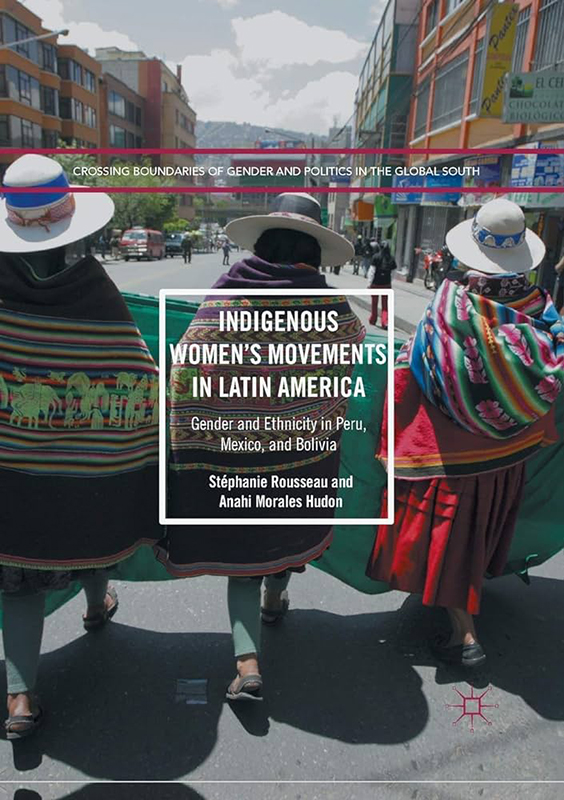 This book presents a comparative analysis of the organizing trajectories of indigenous women’s movements in Peru, Mexico, and Bolivia. The authors’ innovative research reveals how the articulation of gender and ethnicity is central to shape indigenous women’s discourses.
This book presents a comparative analysis of the organizing trajectories of indigenous women’s movements in Peru, Mexico, and Bolivia. The authors’ innovative research reveals how the articulation of gender and ethnicity is central to shape indigenous women’s discourses.
It explores the political contexts and internal dynamics of indigenous movements, to show that they created different opportunities for women to organize and voice specific demands. This, in turn, led to various forms of organizational autonomy for women involved in indigenous movements. The trajectories vary from the creation of autonomous spaces within mixed-gender organizations to the creation of independent organizations. Another pattern is that of women’s organizations maintaining an affiliation to a male-dominated mixed-gender organization, or what the authors call “gender parallelism”. This book illustrates how, in the last two decades, indigenous women have challenged various forms of exclusion through different strategies, transforming indigenous movements’ organizations and collective identities. - Publisher's Description
Request this Title
Thunder Shaman
Bacigalupo, Ana Mariella (2016)
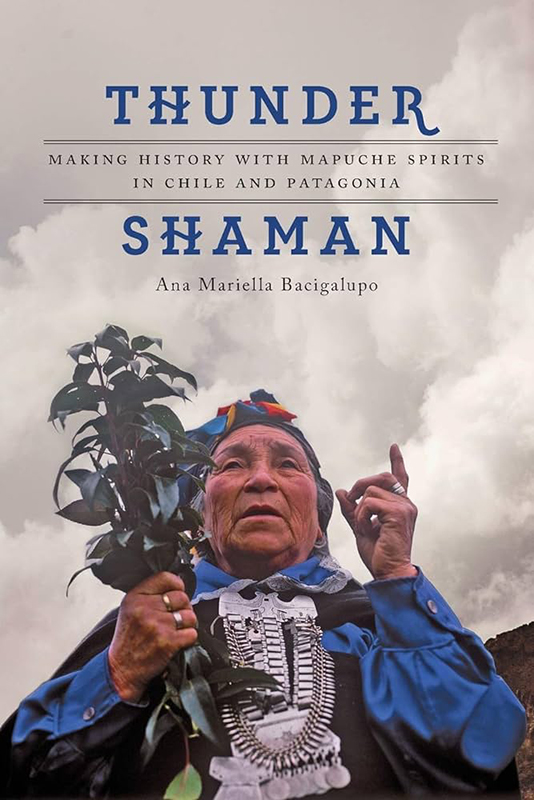 As a “wild,” drumming thunder shaman, a warrior mounted on her spirit horse, Francisca Kolipi’s spirit traveled to other historical times and places, gaining the power and knowledge to conduct spiritual warfare against her community’s enemies, including forestry companies and settlers. As a “civilized” shaman, Francisca narrated the Mapuche people’s attachment to their local sacred landscapes, which are themselves imbued with shamanic power, and constructed nonlinear histories of intra- and interethnic relations that created a moral order in which Mapuche become history’s spiritual victors.
As a “wild,” drumming thunder shaman, a warrior mounted on her spirit horse, Francisca Kolipi’s spirit traveled to other historical times and places, gaining the power and knowledge to conduct spiritual warfare against her community’s enemies, including forestry companies and settlers. As a “civilized” shaman, Francisca narrated the Mapuche people’s attachment to their local sacred landscapes, which are themselves imbued with shamanic power, and constructed nonlinear histories of intra- and interethnic relations that created a moral order in which Mapuche become history’s spiritual victors.
"Thunder Shaman" represents an extraordinary collaboration between Francisca Kolipi and anthropologist Ana Mariella Bacigalupo, who became Kolipi’s “granddaughter,” trusted helper, and agent in a mission of historical (re)construction and myth-making. The book describes Francisca’s life, death, and expected rebirth, and shows how she remade history through multitemporal dreams, visions, and spirit possession, drawing on ancestral beings and forest spirits as historical agents to obliterate state ideologies and the colonialist usurpation of indigenous lands. Both an academic text and a powerful ritual object intended to be an agent in shamanic history, "Thunder Shaman" functions simultaneously as a shamanic “bible,” embodying Francisca’s power, will, and spirit long after her death in 1996, and an insightful study of shamanic historical consciousness, in which biography, spirituality, politics, ecology, and the past, present, and future are inextricably linked. It demonstrates how shamans are constituted by historical-political and ecological events, while they also actively create history itself through shamanic imaginaries and narrative forms. - Publisher's Description
Request this Title
Native American Almanac
Dennis, Yvonne Wakim; Hirschfelder, Arlene; Flynn, Shannon Rothenberger (2016)
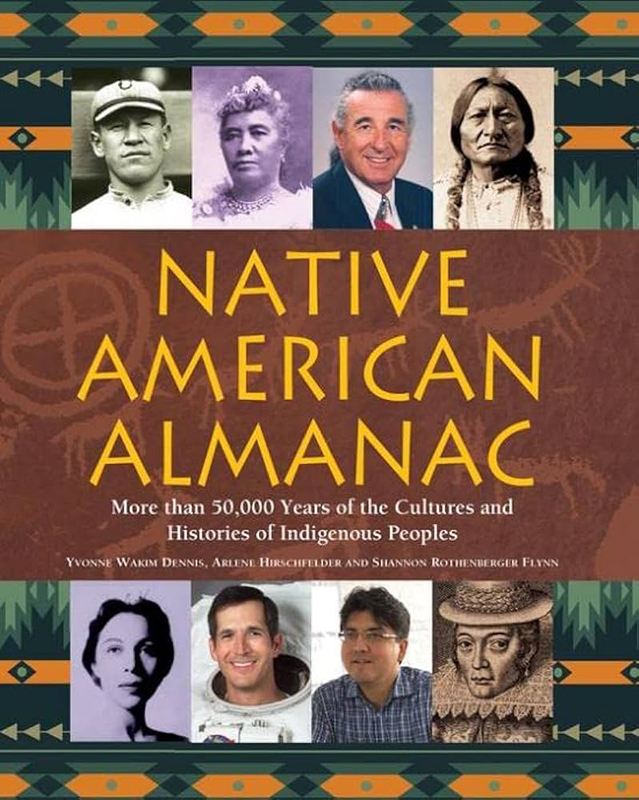 The impact of early encounters, past policies, treaties, wars, and prejudices toward America’s Indigenous peoples is a legacy that continues to mark America. The history of the United States and Native Americans are intertwined. Agriculture, place names, and language have all been influenced by Native American culture. The stories and history of pre- and post-colonial Tribal Nations and peoples continue to resonate and informs the geographical boundaries, laws, language and modern life.
The impact of early encounters, past policies, treaties, wars, and prejudices toward America’s Indigenous peoples is a legacy that continues to mark America. The history of the United States and Native Americans are intertwined. Agriculture, place names, and language have all been influenced by Native American culture. The stories and history of pre- and post-colonial Tribal Nations and peoples continue to resonate and informs the geographical boundaries, laws, language and modern life.
From ancient rock drawings to today’s urban living, the "Native American Almanac: More than 50,000 Years of the Cultures and Histories of Indigenous Peoples" traces the rich heritage of indigenous people. It is a fascinating mix of biography, pre-contact and post-contact history, current events, Tribal Nations’ histories, enlightening insights on environmental and land issues, arts, treaties, languages, education, movements, and more. Ten regional chapters, including urban living, cover the narrative history, the communities, land, environment, important figures, and backgrounds of each area’s Tribal Nations and peoples. The stories of 345 Tribal Nations, biographies of 400 influential figures in all walks of life, Native American firsts, awards, and statistics are covered. 150 photographs and illustrations bring the text to life. - Publisher's Description
Request this Title
Rock Art in an Indigenous Landscape
Lenik, Edward; Gibbs, Nancy (2021)
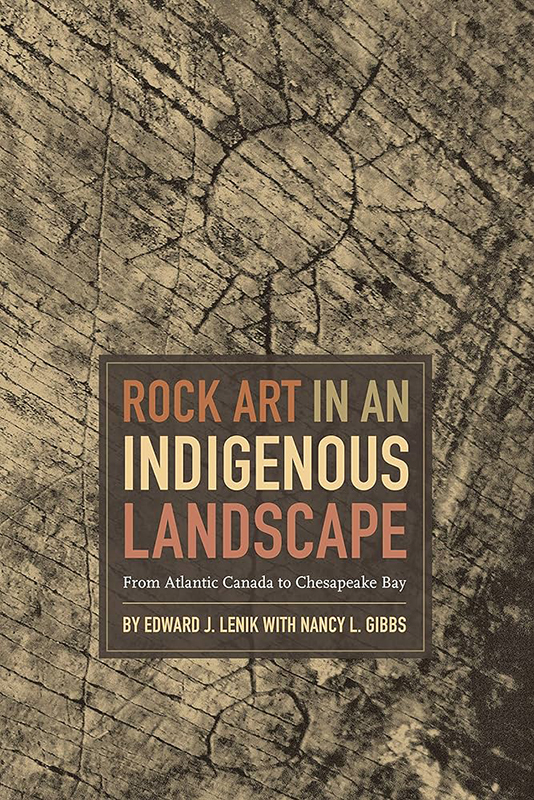 Rock art, petroglyphs, and pictographs have been made by indigenous peoples for thousands of years. Images have been found on bedrock, cliff faces, ridge tops, and boulders and in rock shelters. Some rock surfaces are covered with abstract and geometric designs such as concentric circles, zigzag lines, grids, and cross-hatched and ladder-like patterns. Others depict humans, footprints and handprints, mammals, serpents, and mythic creatures. All were meticulously pecked, incised or painted. This ancient art form connects us to Native Americans’ past, traditions, world views, and sacred places.
Rock art, petroglyphs, and pictographs have been made by indigenous peoples for thousands of years. Images have been found on bedrock, cliff faces, ridge tops, and boulders and in rock shelters. Some rock surfaces are covered with abstract and geometric designs such as concentric circles, zigzag lines, grids, and cross-hatched and ladder-like patterns. Others depict humans, footprints and handprints, mammals, serpents, and mythic creatures. All were meticulously pecked, incised or painted. This ancient art form connects us to Native Americans’ past, traditions, world views, and sacred places.
"Rock Art in an Indigenous Landscape: From Atlantic Canada to Chesapeake Bay" is the culmination of the research of preeminent rock art scholar Edward J. Lenik. Here, he profiles more than 64 examples of rock art in varied locations from Nova Scotia to Maryland. Chapters are organized geographically and lead the reader through coastal sites, rivers and streams, lakes and ponds, and upland sites.
Lenik discusses the rock art examples in the context of the indigenous landscape, noting the significance of the place of discovery. Coverage includes a meticulous description of the design or motif and suggestions of time frame, artist-makers, and interpretations. Where possible, indigenous views on the artifacts enrich the narrative. Other invaluable elements are a discussion of how to identify indigenous rock art; a glossary of rock art terms and features and archaeological culture periods; an up-to-date bibliography; and an appendix of a number of reported but unconfirmed petroglyph sites in the regions. - Publisher's Description
Request this Title
Roots of Entanglement
Rutherdale, Myra; Abel, Kerry; Lackenbauer, P. Whitney (2018)
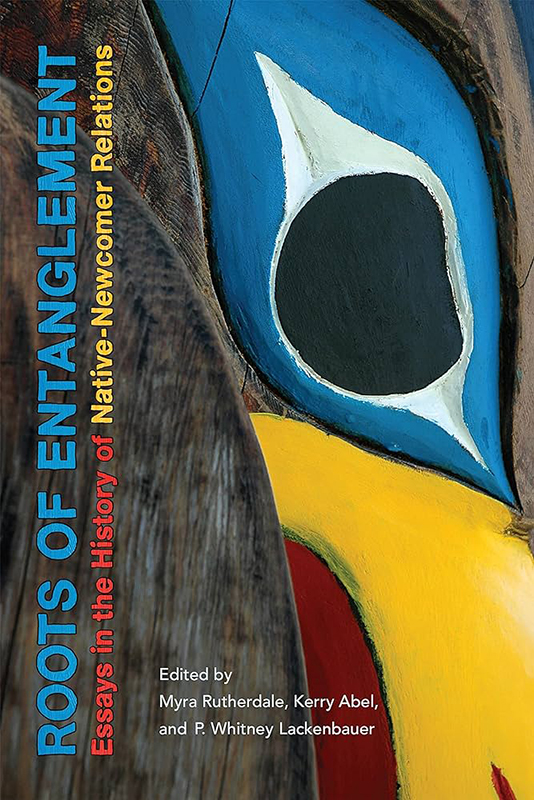 "Roots of Entanglement" offers an historical exploration of the relationships between Indigenous peoples and European newcomers in the territory that would become Canada. Various engagements between Indigenous peoples and the state are emphasized and questions are raised about the ways in which the past has been perceived and how those perceptions have shaped identity and, in turn, interaction both past and present.
"Roots of Entanglement" offers an historical exploration of the relationships between Indigenous peoples and European newcomers in the territory that would become Canada. Various engagements between Indigenous peoples and the state are emphasized and questions are raised about the ways in which the past has been perceived and how those perceptions have shaped identity and, in turn, interaction both past and present.
Specific topics such as land, resources, treaties, laws, policies, and cultural politics are explored through a range of perspectives that reflect state-of-the-art research in the field of Indigenous history. Editors Myra Rutherdale, Whitney Lackenbauer, and Kerry Abel have assembled an array of top scholars including luminaries such as Keith Carlson, Bill Waiser, Skip Ray, and Ken Coates. "Roots of Entanglement" is a direct response to the Truth and Reconciliation Commission’s call for a better appreciation of the complexities of history in the relationship between Indigenous and non-Indigenous peoples in Canada. - Publisher's Description
Request this Title
Are We Not Foreigners Here?
Schulze, Jeffrey (2018)
 Since its inception, the U.S.-Mexico border has invited the creation of cultural, economic, and political networks that often function in defiance of surrounding nation-states. It has also produced individual and group identities that are as subversive as they are dynamic. In "Are We Not Foreigners Here?," Jeffrey M. Schulze explores how the U.S.-Mexico border shaped the concepts of nationhood and survival strategies of three Indigenous tribes who live in this borderland: the Yaqui, Kickapoo, and Tohono O'odham. These tribes have historically fought against nation-state interference, employing strategies that draw on their transnational orientation to survive and thrive.
Since its inception, the U.S.-Mexico border has invited the creation of cultural, economic, and political networks that often function in defiance of surrounding nation-states. It has also produced individual and group identities that are as subversive as they are dynamic. In "Are We Not Foreigners Here?," Jeffrey M. Schulze explores how the U.S.-Mexico border shaped the concepts of nationhood and survival strategies of three Indigenous tribes who live in this borderland: the Yaqui, Kickapoo, and Tohono O'odham. These tribes have historically fought against nation-state interference, employing strategies that draw on their transnational orientation to survive and thrive.
Schulze details the complexities of the tribes' claims to nationhood in the context of the border from the nineteenth century to the present. He shows that in spreading themselves across two powerful, omnipresent nation-states, these tribes managed to maintain separation from currents of federal Indian policy in both countries; at the same time, it could also leave them culturally and politically vulnerable, especially as surrounding powers stepped up their efforts to control transborder traffic. Schulze underlines these tribes' efforts to reconcile their commitment to preserving their identities, asserting their nationhood, and creating transnational links of resistance with an increasingly formidable international boundary. - Publisher's Description
Request this Title
Indigenous Interfaces
Menjívar, Gómez; Carolina, Jennifer (2019)
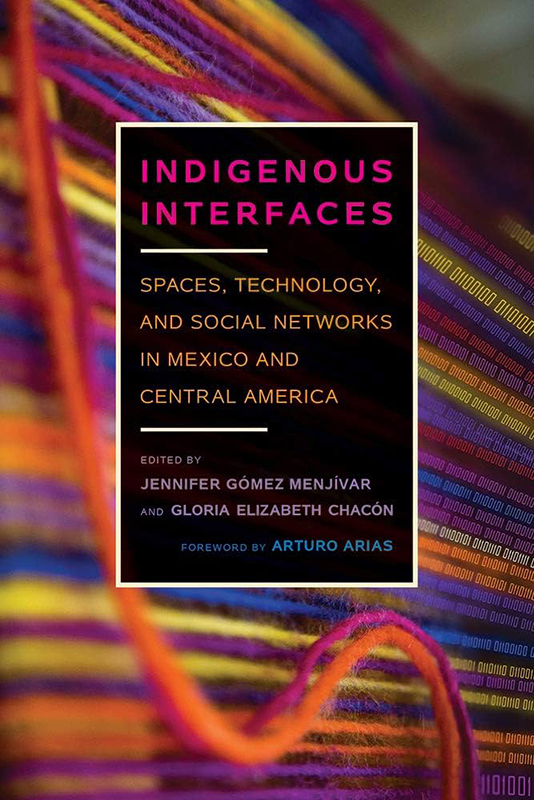 Cultural preservation, linguistic revitalization, intellectual heritage, and environmental sustainability became central to Indigenous movements in Mexico and Central America after 1992. While the emergence of these issues triggered important conversations, none to date have examined the role that new media has played in accomplishing their objectives.
Cultural preservation, linguistic revitalization, intellectual heritage, and environmental sustainability became central to Indigenous movements in Mexico and Central America after 1992. While the emergence of these issues triggered important conversations, none to date have examined the role that new media has played in accomplishing their objectives.
"Indigenous Interfaces" provides the first thorough examination of indigeneity at the interface of cyberspace. Correspondingly, it examines the impact of new media on the struggles for self-determination that Indigenous peoples undergo in Mexico and Central America. The volume’s contributors highlight the fresh approaches that Mesoamerica’s Indigenous peoples have given to new media—from YouTubing Maya rock music to hashtagging in Zapotec. Together, they argue that these cyberspatial activities both maintain tradition and ensure its continuity. Without considering the implications of new technologies, "Indigenous Interfaces" argues, twenty-first-century indigeneity in Mexico and Central America cannot be successfully documented, evaluated, and comprehended.
"Indigenous Interfaces" rejects the myth that indigeneity and information technology are incompatible through its compelling analysis of the relationships between Indigenous peoples and new media. The volume illustrates how Indigenous peoples are selectively and strategically choosing to interface with cybertechnology, highlights Indigenous interpretations of new media, and brings to center Indigenous communities who are resetting modes of communication and redirecting the flow of information. It convincingly argues that interfacing with traditional technologies simultaneously with new media gives Indigenous peoples an edge on the claim to autonomous and sovereign ways of being Indigenous in the twenty-first century. - Publisher's Description
Request this Title
The Death of Aztec Tenochtitlan, the Life of Mexico City
Mundy, Barbara (2015)
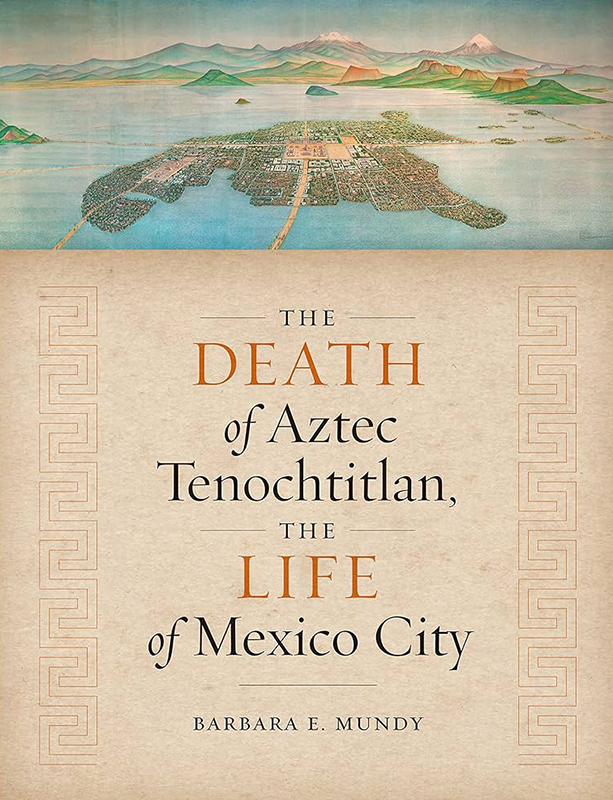 The capital of the Aztec empire, Tenochtitlan, was, in its era, one of the largest cities in the world. Built on an island in the middle of a shallow lake, its population numbered perhaps 150,000, with another 350,000 people in the urban network clustered around the lake shores. In 1521, at the height of Tenochtitlan’s power, which extended over much of Central Mexico, Hernando Cortés and his followers conquered the city. Cortés boasted to King Charles V of Spain that Tenochtitlan was “destroyed and razed to the ground.” But was it?
The capital of the Aztec empire, Tenochtitlan, was, in its era, one of the largest cities in the world. Built on an island in the middle of a shallow lake, its population numbered perhaps 150,000, with another 350,000 people in the urban network clustered around the lake shores. In 1521, at the height of Tenochtitlan’s power, which extended over much of Central Mexico, Hernando Cortés and his followers conquered the city. Cortés boasted to King Charles V of Spain that Tenochtitlan was “destroyed and razed to the ground.” But was it?
Drawing on period representations of the city in sculptures, texts, and maps, "The Death of Aztec Tenochtitlan, the Life of Mexico City" builds a convincing case that this global capital remained, through the sixteenth century, very much an Amerindian city. Barbara E. Mundy foregrounds the role the city’s indigenous peoples, the Nahua, played in shaping Mexico City through the construction of permanent architecture and engagement in ceremonial actions. She demonstrates that the Aztec ruling elites, who retained power even after the conquest, were instrumental in building and then rebuilding the city. Mundy shows how the Nahua entered into mutually advantageous alliances with the Franciscans to maintain the city's sacred nodes. She also focuses on the practical and symbolic role of the city’s extraordinary waterworks—the product of a massive ecological manipulation begun in the fifteenth century—to reveal how the Nahua struggled to maintain control of water resources in early Mexico City. - Publisher's Description
Request this Title
An Afro-Indigenous History of the United States
Mays, Kyle (2015)
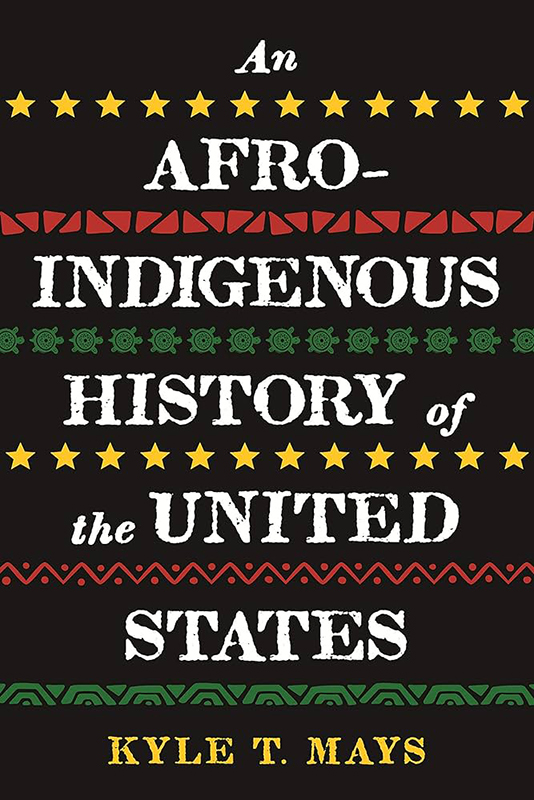 Beginning with pre-Revolutionary America and moving into the movement for Black lives and contemporary Indigenous activism, Afro-Indigenous historian Kyle T. Mays argues that the foundations of the US are rooted in antiblackness and settler colonialism, and that these parallel oppressions continue into the present. He explores how Black and Indigenous peoples have always resisted and struggled for freedom, sometimes together, and sometimes apart. Whether to end African enslavement and Indigenous removal or eradicate capitalism and colonialism, Mays show how the fervor of Black and Indigenous peoples calls for justice have consistently sought to uproot white supremacy.
Beginning with pre-Revolutionary America and moving into the movement for Black lives and contemporary Indigenous activism, Afro-Indigenous historian Kyle T. Mays argues that the foundations of the US are rooted in antiblackness and settler colonialism, and that these parallel oppressions continue into the present. He explores how Black and Indigenous peoples have always resisted and struggled for freedom, sometimes together, and sometimes apart. Whether to end African enslavement and Indigenous removal or eradicate capitalism and colonialism, Mays show how the fervor of Black and Indigenous peoples calls for justice have consistently sought to uproot white supremacy.
Mays uses a wide-array of historical activists and pop culture icons, “sacred” texts, and foundational texts like the Declaration of Independence and Democracy in America. He covers the civil rights movement and freedom struggles of the 1960s and 1970s, and explores current debates around the use of Native American imagery and the cultural appropriation of Black culture. Mays compels us to rethink both our history as well as contemporary debates and to imagine the powerful possibilities of Afro-Indigenous solidarity. - Publisher's Description
Request this Title
Before American History
Mucher, Christen (2022)
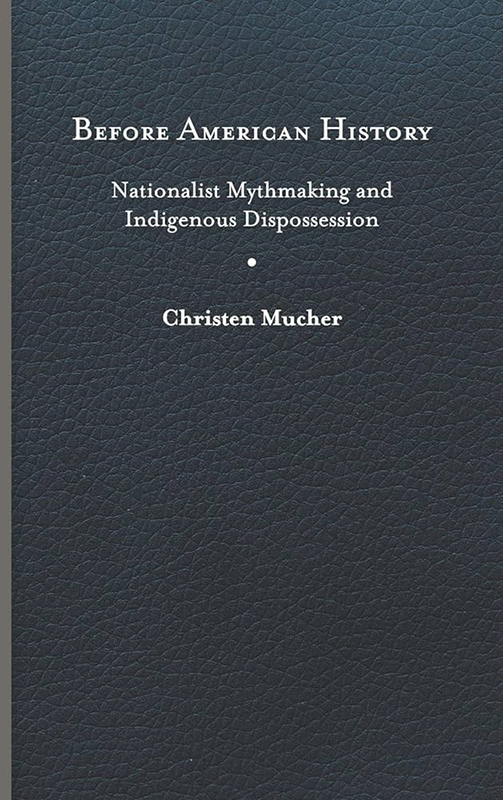 "Before American History" juxtaposes Mexico City’s famous carved Sun Stone with the mounded earthworks found throughout the Midwestern states of the U.S. to examine the project of settler nationalism from the 1780s to the 1840s in two North American republics usually studied separately. As the U.S. and Mexico transformed from European colonies into independent nations―and before war scarred them both―antiquarians and historians compiled and interpreted archives meant to document America’s Indigenous pasts. These settler-colonial understandings of North America’s past deliberately misappropriated Indigenous histories and repurposed them and their material objects as "American antiquities," thereby writing Indigenous pasts out of U.S. and Mexican national histories and national lands and erasing and denigrating Native peoples living in both nascent republics.
"Before American History" juxtaposes Mexico City’s famous carved Sun Stone with the mounded earthworks found throughout the Midwestern states of the U.S. to examine the project of settler nationalism from the 1780s to the 1840s in two North American republics usually studied separately. As the U.S. and Mexico transformed from European colonies into independent nations―and before war scarred them both―antiquarians and historians compiled and interpreted archives meant to document America’s Indigenous pasts. These settler-colonial understandings of North America’s past deliberately misappropriated Indigenous histories and repurposed them and their material objects as "American antiquities," thereby writing Indigenous pasts out of U.S. and Mexican national histories and national lands and erasing and denigrating Native peoples living in both nascent republics.
Christen Mucher creatively recovers the Sun Stone and mounded earthworks as archives of nationalist power and Indigenous dispossession as well as objects that are, at their material base, produced by Indigenous people but settler controlled and settler interpreted. Her approach renders visible the foundational methodologies, materials, and mythologies that created an American history out of and on top of Indigenous worlds and facilitated Native dispossession continent-wide. By writing Indigenous actors out of national histories, Mexican and U.S. elites also wrote them out of their lands, a legacy of erasure and removal that continues when we repeat these eighteenth- and nineteenth-century settler narratives and that reverberates in discussions of immigration, migration, and Nativism today. - Publisher's Description
Request this Title
Indians Playing Indian
Siebert, Monika (2015)
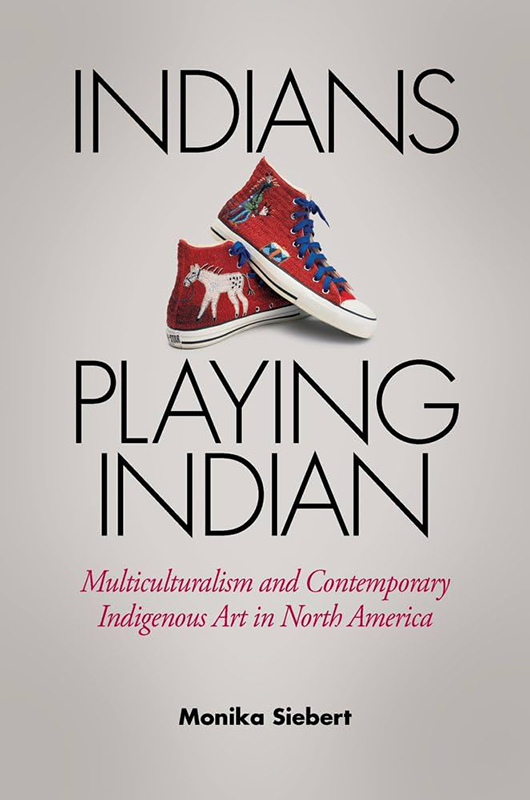 Contemporary indigenous peoples in North America confront a unique predicament. While they are reclaiming their historic status as sovereign nations, mainstream popular culture continues to depict them as cultural minorities similar to other ethnic Americans. These depictions of indigenous peoples as “Native Americans” complete the broader narrative of America as a refuge to the world’s immigrants and a home to contemporary multicultural democracies, such as the United States and Canada. But they fundamentally misrepresent indigenous peoples, whose American history has been not of immigration but of colonization.
Contemporary indigenous peoples in North America confront a unique predicament. While they are reclaiming their historic status as sovereign nations, mainstream popular culture continues to depict them as cultural minorities similar to other ethnic Americans. These depictions of indigenous peoples as “Native Americans” complete the broader narrative of America as a refuge to the world’s immigrants and a home to contemporary multicultural democracies, such as the United States and Canada. But they fundamentally misrepresent indigenous peoples, whose American history has been not of immigration but of colonization.
Monika Siebert’s "Indians Playing Indian" first identifies this phenomenon as multicultural misrecognition, explains its sources in North American colonial history and in the political mandates of multiculturalism, and describes its consequences for contemporary indigenous cultural production. It then explores the responses of indigenous artists who take advantage of the ongoing popular interest in Native American culture and art while offering narratives of the political histories of their nations in order to resist multicultural incorporation.
Each chapter of "Indians Playing Indian" showcases a different medium of contemporary indigenous art—museum exhibition, cinema, digital fine art, sculpture, multimedia installation, and literary fiction—and explores specific rhetorical strategies artists deploy to forestall multicultural misrecognition and recover political meanings of indigeneity. The sites and artists discussed include the National Museum of the American Indian in Washington, DC; filmmakers at Inuit Isuma Productions; digital artists/photographers Dugan Aguilar, Pamela Shields, and Hulleah Tsinhnahjinnie; sculptor Jimmie Durham; and novelist LeAnne Howe. - Publisher's Description
Request this Title
Singing for the Dead
Faudree, Paja (2013)
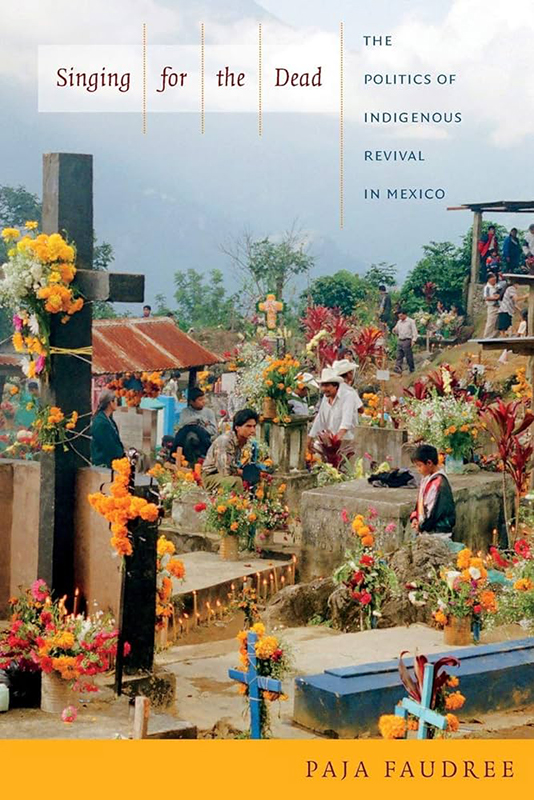 "Singing for the Dead" chronicles ethnic revival in Oaxaca, Mexico, where new forms of singing and writing in the local Mazatec indigenous language are producing powerful, transformative political effects. Paja Faudree argues for the inclusion of singing as a necessary component in the polarized debates about indigenous orality and literacy, and she considers how the coupling of literacy and song has allowed people from the region to create texts of enduring social resonance. She examines how local young people are learning to read and write in Mazatec as a result of the region's new Day of the Dead song contest.
"Singing for the Dead" chronicles ethnic revival in Oaxaca, Mexico, where new forms of singing and writing in the local Mazatec indigenous language are producing powerful, transformative political effects. Paja Faudree argues for the inclusion of singing as a necessary component in the polarized debates about indigenous orality and literacy, and she considers how the coupling of literacy and song has allowed people from the region to create texts of enduring social resonance. She examines how local young people are learning to read and write in Mazatec as a result of the region's new Day of the Dead song contest.
Faudree also studies how tourist interest in local psychedelic mushrooms has led to their commodification, producing both opportunities and challenges for songwriters and others who represent Mazatec culture. She situates these revival movements within the contexts of Mexico and Latin America, as well as the broad, hemisphere-wide movement to create indigenous literatures. Singing for the Dead provides a new way to think about the politics of ethnicity, the success of social movements, and the limits of national belonging. - Publisher's Description
Request this Title
The Creator's Game
Downey, Allan (2018)
 Lacrosse has been a central element of Indigenous cultures for centuries, but once non-Indigenous players entered the sport, it became a site of appropriation – then reclamation – of Indigenous identities. "The Creator’s Game" focuses on the history of lacrosse in Indigenous communities from the 1860s to the 1990s, exploring Indigenous-non-Indigenous relations and Indigenous identity formation.
Lacrosse has been a central element of Indigenous cultures for centuries, but once non-Indigenous players entered the sport, it became a site of appropriation – then reclamation – of Indigenous identities. "The Creator’s Game" focuses on the history of lacrosse in Indigenous communities from the 1860s to the 1990s, exploring Indigenous-non-Indigenous relations and Indigenous identity formation.
While the game was being appropriated in the process of constructing a new identity for the nation-state of Canada, it was also being used by Indigenous peoples to resist residential school experiences, initiate pan-Indigenous political mobilization, and articulate Indigenous sovereignty. This engaging and innovative book provides a unique view of Indigenous self-determination and nationhood in the face of settler-colonialism. - Publisher's Description
Request this Title
A Drum in One Hand, a Sockeye in the Other
Cote, Charlotte (2022)
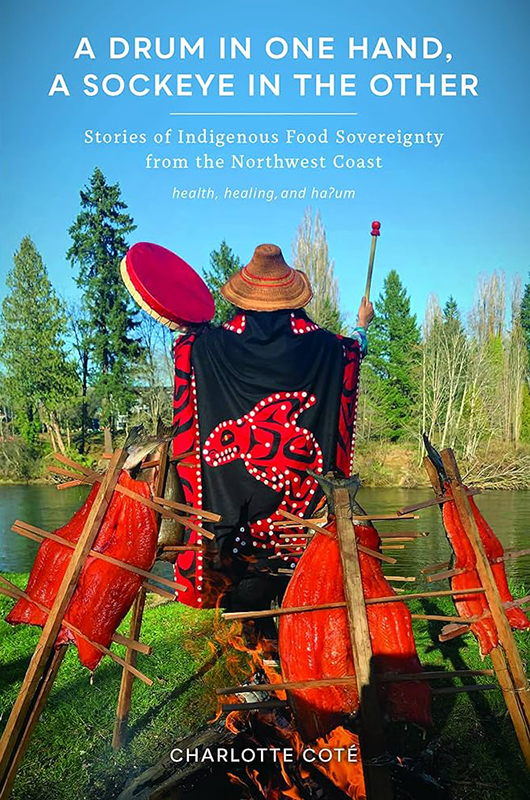 In the dense rainforest of the west coast of Vancouver Island, the Somass River (uumaas) brings sockeye salmon (miaat) into the Nuu-chah-nulth community of Tseshaht, umaas and miaat are central to the sacred food practices that have been a crucial part of the Indigenous community's efforts to enact food sovereignty, decolonize their diet, and preserve their ancestral knowledge.
In the dense rainforest of the west coast of Vancouver Island, the Somass River (uumaas) brings sockeye salmon (miaat) into the Nuu-chah-nulth community of Tseshaht, umaas and miaat are central to the sacred food practices that have been a crucial part of the Indigenous community's efforts to enact food sovereignty, decolonize their diet, and preserve their ancestral knowledge.
In "A Drum in One Hand, a Sockeye in the Other," Charlotte Coté shares contemporary Nuu-chah-nulth practices of traditional food revitalization in the context of broader efforts to re-Indigenize contemporary diets on the Northwest Coast. Coté offers evocative stories of her Tseshaht community's and her own work to revitalize relationships to haʔum (traditional food) as a way to nurture health and wellness. As Indigenous peoples continue to face food insecurity due to ongoing inequality, environmental degradation, and the Westernization of traditional diets, Coté foregrounds healing and cultural sustenance via everyday enactments of food sovereignty: berry picking, salmon fishing, and building a community garden on reclaimed residential school grounds. This book is for everyone concerned about the major role food plays in physical, emotional, and spiritual wellness. - Publisher's Description
Request this Title
The Indigenous Peoples of Mesoamerica and Central America
Carmack, Robert (2017)
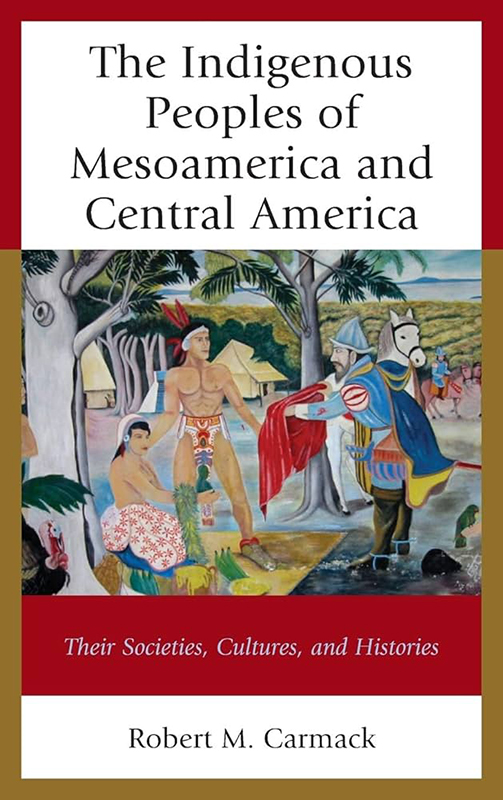 In "The Indigenous Peoples of Mesoamerica and Central America," Robert Carmack focuses on K’iche’ natives of Guatemala, Masayan peoples of Nicaragua, and the native peoples of Buenos Aires and Costa Rica. Starting with Christopher Columbus’ proclaimed “discovery” of Central America, Carmack illustrates the Central American native peoples’ dramatic struggles for survival, native languages, and unique communities and states.
In "The Indigenous Peoples of Mesoamerica and Central America," Robert Carmack focuses on K’iche’ natives of Guatemala, Masayan peoples of Nicaragua, and the native peoples of Buenos Aires and Costa Rica. Starting with Christopher Columbus’ proclaimed “discovery” of Central America, Carmack illustrates the Central American native peoples’ dramatic struggles for survival, native languages, and unique communities and states.
Carmack draws on the fieldwork that he has conducted over the past fifty years to highlight the diversity of the Central American peoples, cultures, and histories, and to explain their significance relative to other native peoples of the world. This book is recommended for scholars of anthropology, Latin American studies, history, and sociology. - Publisher's Description
Request this Title
Boarding School Voices
Krupat, Arnold (2021)
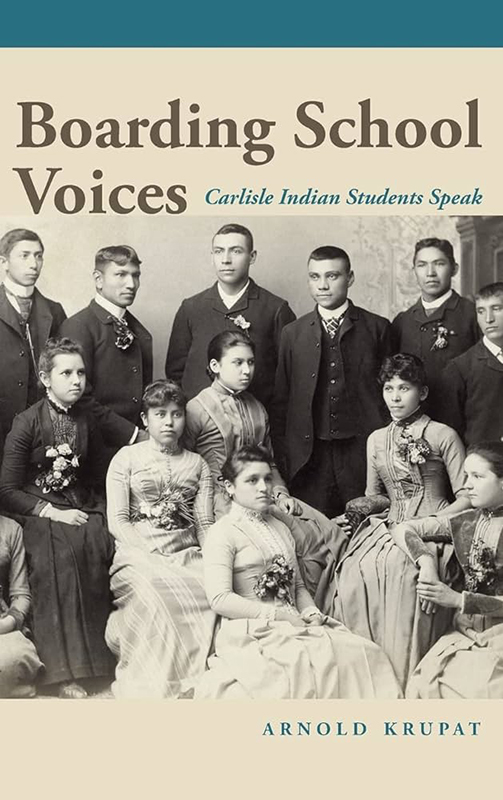 "Boarding School Voices" is both an anthology of mostly unpublished writing by former students of the Carlisle Indian Industrial School and a study of that writing. The boarding schools’ ethnocidal practices have become a metaphor for the worst evils of colonialism, a specifiable source for the ills that beset Native communities today. But the fuller story is one not only of suffering and pain, loss and abjection, but also of ingenious agency, creative syntheses, and unimagined adaptations.
"Boarding School Voices" is both an anthology of mostly unpublished writing by former students of the Carlisle Indian Industrial School and a study of that writing. The boarding schools’ ethnocidal practices have become a metaphor for the worst evils of colonialism, a specifiable source for the ills that beset Native communities today. But the fuller story is one not only of suffering and pain, loss and abjection, but also of ingenious agency, creative syntheses, and unimagined adaptations.
Although tragic for many students, for others the Carlisle experience led to positive outcomes in their lives. Some published short pieces in the Carlisle newspapers and others sent letters and photos to the school over the years. Arnold Krupat transcribes selections from the letters of these former students literally and unedited, emphasizing their evocative language and what they tell of themselves and their home communities, and the perspectives they offer on a wider American world. Their sense of themselves and their worldview provide detailed insights into what was abstractly and vaguely referred to as “the Indian question.” These former students were the oxymoron Carlisle superintendent Richard Henry Pratt could not imagine and never comprehended: they were Carlisle Indians. - Publisher's Description
Request this Title
Aztec, Salmon, and the Puebloan Heartland of the Middle San Juan
Brown, Gary; Reed, Paul (2018)
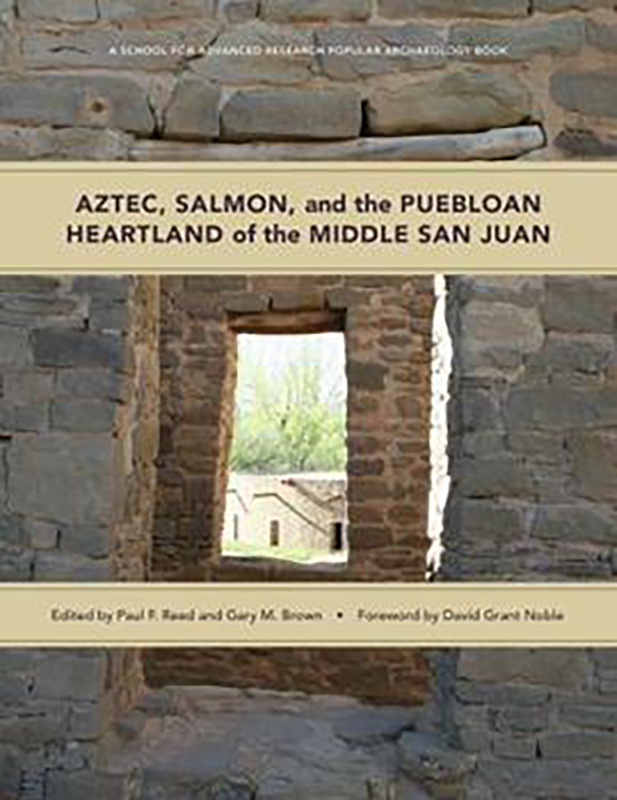 Often overshadowed by the Ancestral Pueblo centers at Chaco Canyon and Mesa Verde, the Middle San Juan is one of the most dynamic territories in the pre-Hispanic Southwest, interacting with Chaco Canyon and Mesa Verde as well as the surrounding regions. This ancient Puebloan heartland was instrumental in tying together Chaco and Mesa Verde cultures to create a distinctive blend of old and new, local and nonlocal. The contributors to this book attribute the development of Salmon and Aztec to migration and colonization by people from Chaco Canyon.
Often overshadowed by the Ancestral Pueblo centers at Chaco Canyon and Mesa Verde, the Middle San Juan is one of the most dynamic territories in the pre-Hispanic Southwest, interacting with Chaco Canyon and Mesa Verde as well as the surrounding regions. This ancient Puebloan heartland was instrumental in tying together Chaco and Mesa Verde cultures to create a distinctive blend of old and new, local and nonlocal. The contributors to this book attribute the development of Salmon and Aztec to migration and colonization by people from Chaco Canyon.
Rather than fighting for control over the territory, Chaco migrants and local leaders worked together to build the great houses of Aztec and Salmon while maintaining their identities and connections with their individual homelands. As a result of this collaboration, the Middle San Juan can be seen as one of the ancient Puebloan heartlands that made important contributions to contemporary Puebloan society. - Publisher's Description
Request this Title
Painful Beauty
Smetzer, Megan (2021)
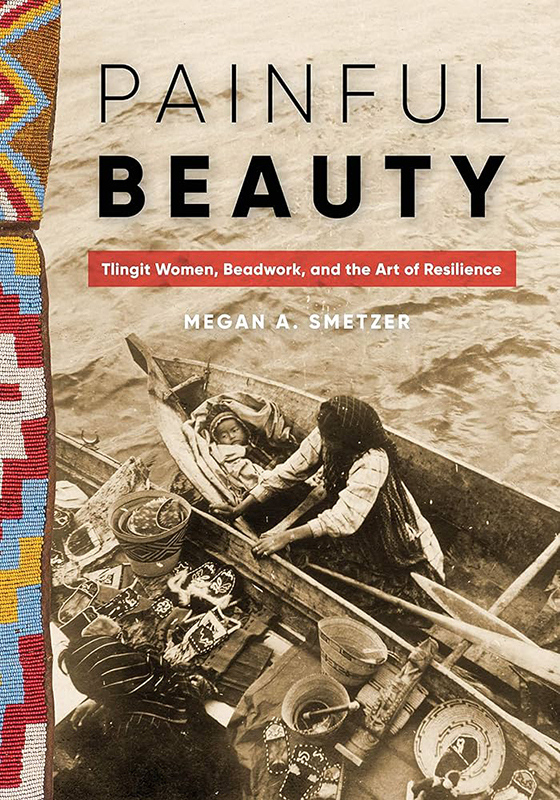 For over 150 years, Tlingit women artists have beaded colorful, intricately beautiful designs on moccasins, dolls, octopus bags, tunics, and other garments. "Painful Beauty" suggests that at a time when Indigenous cultural practices were actively being repressed, beading supported cultural continuity, demonstrating Tlingit women's resilience, strength, and power. Beadwork served many uses, from the ceremonial to the economic, as women created beaded pieces for community use and to sell to tourists. Like other Tlingit art, beadwork reflects rich artistic visions with deep connections to the environment, clan histories, and Tlingit worldviews. Contemporary Tlingit artists Alison Bremner, Chloe French, Shgen Doo Tan George, Lily Hudson Hope, Tanis S'eiltin, and Larry McNeil foreground the significance of historical beading practices in their diverse, boundary-pushing artworks.
For over 150 years, Tlingit women artists have beaded colorful, intricately beautiful designs on moccasins, dolls, octopus bags, tunics, and other garments. "Painful Beauty" suggests that at a time when Indigenous cultural practices were actively being repressed, beading supported cultural continuity, demonstrating Tlingit women's resilience, strength, and power. Beadwork served many uses, from the ceremonial to the economic, as women created beaded pieces for community use and to sell to tourists. Like other Tlingit art, beadwork reflects rich artistic visions with deep connections to the environment, clan histories, and Tlingit worldviews. Contemporary Tlingit artists Alison Bremner, Chloe French, Shgen Doo Tan George, Lily Hudson Hope, Tanis S'eiltin, and Larry McNeil foreground the significance of historical beading practices in their diverse, boundary-pushing artworks.
Working with museum collection materials, photographs, archives, and interviews with artists and elders, Megan Smetzer reframes this often overlooked artform as a site of historical negotiations and contemporary inspirations. She shows how beading gave Tlingit women the freedom to innovate aesthetically, assert their clan crests and identities, support tribal sovereignty, and pass on cultural knowledge. "Painful Beauty" is the first dedicated study of Tlingit beadwork and contributes to the expanding literature addressing women's artistic expressions on the Northwest Coast. - Publisher's Description
Request this Title
Feature image by Bernardo Ramonfaur on Unsplash
